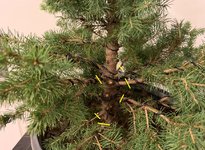D
Deleted member 47471
Guest
Dwarf Alberta Spruce
1. Is there a better place to cut on the semi-mature and mature primary branches (featured below) to use as cuttings to make a group planting?

2. My books recommend cutting just below junctions but on softwood only without mention of hardwood. Does the same principle, then, apply with more mature and woody cuttings?
3. Is simply wetting the cut site and coating with root hormone sufficient to promote root growth?
4. Lastly, is it necessary to use a peat moss and perlite mix only for the soil, or is a standard organic potting soil okay?
The books recommend Autumn - Winter as the best/appropriate time for taking and planting cuttings, so it seems now would be fine. I have an unheated and dimly lit (with windows) garage where my trees reside for the remainder of Winter.
1. Is there a better place to cut on the semi-mature and mature primary branches (featured below) to use as cuttings to make a group planting?

2. My books recommend cutting just below junctions but on softwood only without mention of hardwood. Does the same principle, then, apply with more mature and woody cuttings?
3. Is simply wetting the cut site and coating with root hormone sufficient to promote root growth?
4. Lastly, is it necessary to use a peat moss and perlite mix only for the soil, or is a standard organic potting soil okay?
The books recommend Autumn - Winter as the best/appropriate time for taking and planting cuttings, so it seems now would be fine. I have an unheated and dimly lit (with windows) garage where my trees reside for the remainder of Winter.
